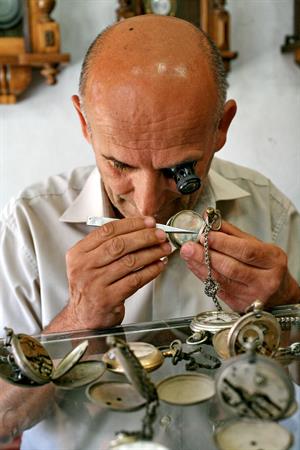PDF chapter test TRY NOW
You might have seen watchmakers using a small magnifying glass to see tiny parts. Have you ever placed your hand on the surface of a magnifying glass? Is it plane or curved? Is it thicker in the centre or on the sides? Spectacle lenses and those used by a watchmaker are examples of lenses. What exactly is a lens? What is the mechanism for bending light rays?
In this section, we will go over them. A lens is formed by a transparent material bound by two surfaces, one or both of which are spherical. A lens is bound by at least one spherical surface in this case. Planes would be the other surface in such lenses.

Lens used by watchmakers
Two spherical surfaces bulging outwards are possible in a lens. A double convex lens is one that has two convex surfaces. It is simply referred to as a convex lens. In comparison to the edges, it is thicker in the middle. Because convex lenses bring light rays together, they are also known as converging lenses. A double concave lens is similarly bounded by two inwardly curved spherical surfaces. It is thicker around the edges than in the centre. Light rays are diverged by such lenses.
Diverging lenses are another name for these types of lenses. A double concave lens is simply called a concave lens.
Diverging lenses are another name for these types of lenses. A double concave lens is simply called a concave lens.

Different kind of lenses
A lens has two spherical surfaces, one convex and the other concave. Each of these surfaces is a sphere in its own right. The centres of these spheres are known as the lens's centres of curvature. The letter \(C\) is commonly used to represent the lens's centre of curvature. We can refer to them as \(C1\) and \(C2\) because there are two centres of curvature. The principal axis of a lens is an imaginary straight line that passes through its two centres of curvature. The optical centre of a lens is its focal point.
A ray of light passing through the optical centre of a lens does not deviate in any way. The aperture of a spherical lens is the effective diameter of the circular outline of the lens. In this Chapter, we will only talk about lenses whose aperture is much smaller than their radius of curvature. The two centres of curvatures are equidistant from the optical centre \(O\). Such lenses are called thin lenses with small ones apertures. What happens when parallel rays of light are incident on a lens? Let us find answers for all these questions in the next section.
Reference:
https://commons.wikimedia.org/wiki/File:Lenses_abcd.png
https://commons.wikimedia.org/wiki/File:25_Gjakov%C3%AB_-_Ortari-_Watchmaker.jpg
